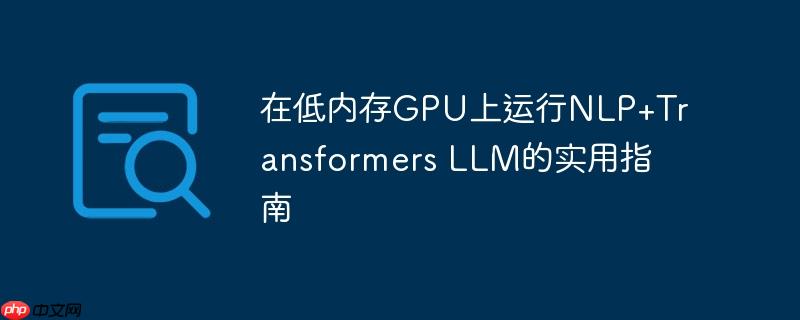
本文档旨在指导用户如何在低内存GPU环境下成功加载和运行大型语言模型(LLM),特别是基于Transformers架构的NLP模型。通过模型量化、AutoAWQ工具的使用以及GPU加速等关键技术,克服内存限制,实现LLM的有效推理。本文将提供详细的代码示例和步骤,帮助读者在资源受限的环境中部署和使用强大的语言模型。
在低内存GPU上运行大型语言模型(LLM)是一个常见的挑战。直接加载未经优化的LLM很容易导致内存溢出,使得模型无法正常运行。本教程将介绍一种有效的解决方案:模型量化,以及如何利用 AutoAWQ 工具来加速和优化推理过程。
模型量化是一种降低模型精度的技术,通过减少模型参数的存储空间,从而降低内存占用。例如,将模型参数从32位浮点数(FP32)量化为8位整数(INT8)或更低的精度,可以显著减小模型体积,同时尽可能保持模型的性能。
AutoAWQ是一个专门用于加速Transformer模型推理的工具。它提供了一种高效的量化方法,可以在不牺牲过多性能的前提下,大幅降低模型的内存需求。
步骤1:安装必要的库
首先,需要安装 transformers、accelerate 和 autoawq 库。由于Colab的CUDA版本可能较旧,建议安装特定版本的 autoawq。
!pip install -q transformers accelerate !pip install -q -U https://github.com/casper-hansen/AutoAWQ/releases/download/v0.1.6/autoawq-0.1.6+cu118-cp310-cp310-linux_x86_64.whl
注意: 上述命令中的 cu118 部分表示CUDA 11.8版本。请根据你的环境选择合适的版本。如果出现兼容性问题,可以尝试其他版本或从源代码编译。
步骤2:加载量化模型
接下来,使用 AutoAWQForCausalLM.from_quantized() 加载量化后的模型。这里我们使用 TheBloke 提供的 neural-chat-7B-v3-1-AWQ 模型作为示例。
import torch from awq import AutoAWQForCausalLM from transformers import AutoTokenizer model_name = 'TheBloke/neural-chat-7B-v3-1-AWQ' model = AutoAWQForCausalLM.from_quantized(model_name) tokenizer = AutoTokenizer.from_pretrained(model_name)
步骤3:编写推理函数
创建一个 generate_response 函数,用于处理输入并生成模型的输出。 关键的一步是将输入张量移动到GPU上,通过 .cuda() 方法实现。
def generate_response(system_input, user_input):
# Format the input using the provided template
prompt = f"### System:\n{system_input}\n### User:\n{user_input}\n### Assistant:\n"
# Tokenize and encode the prompt
inputs = tokenizer.encode(prompt, return_tensors="pt", add_special_tokens=False).cuda()
# Generate a response
outputs = model.generate(inputs, max_length=1000, num_return_sequences=1)
response = tokenizer.decode(outputs[0], skip_special_tokens=True)
# Extract only the assistant's response
return response.split("### Assistant:\n")[-1]步骤4:测试模型
最后,使用示例输入测试模型,验证其是否正常工作。
# Example usage system_input = "You are a math expert assistant. Your mission is to help users understand and solve various math problems. You should provide step-by-step solutions, explain reasonings and give the correct answer." user_input = "calculate 100 + 520 + 60" response = generate_response(system_input, user_input) print(response)
通过模型量化和 AutoAWQ 工具的使用,可以在低内存 GPU 上成功运行大型语言模型,为资源受限的环境下的 NLP 应用提供了可能性。 掌握这些技术,能够更有效地利用有限的计算资源,构建强大的AI应用。
以上就是在低内存GPU上运行NLP+Transformers LLM的实用指南的详细内容,更多请关注php中文网其它相关文章!

每个人都需要一台速度更快、更稳定的 PC。随着时间的推移,垃圾文件、旧注册表数据和不必要的后台进程会占用资源并降低性能。幸运的是,许多工具可以让 Windows 保持平稳运行。

 C++高性能并发应用_C++如何开发性能关键应用
C++高性能并发应用_C++如何开发性能关键应用
 Java AI集成Deep Java Library_Java怎么集成AI模型部署
Java AI集成Deep Java Library_Java怎么集成AI模型部署
 Golang后端API开发_Golang如何高效开发后端和API
Golang后端API开发_Golang如何高效开发后端和API
 Python异步并发改进_Python异步编程有哪些新改进
Python异步并发改进_Python异步编程有哪些新改进
 C++系统编程内存管理_C++系统编程怎么与Rust竞争内存安全
C++系统编程内存管理_C++系统编程怎么与Rust竞争内存安全
 Java GraalVM原生镜像构建_Java怎么用GraalVM构建高效原生镜像
Java GraalVM原生镜像构建_Java怎么用GraalVM构建高效原生镜像
 Python FastAPI异步API开发_Python怎么用FastAPI构建异步API
Python FastAPI异步API开发_Python怎么用FastAPI构建异步API
 C++现代C++20/23/26特性_现代C++有哪些新标准特性如modules和coroutines
C++现代C++20/23/26特性_现代C++有哪些新标准特性如modules和coroutines
Copyright 2014-2025 https://www.php.cn/ All Rights Reserved | php.cn | 湘ICP备2023035733号